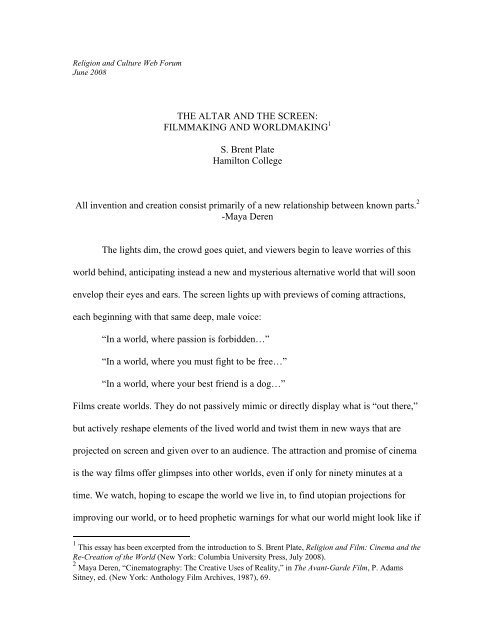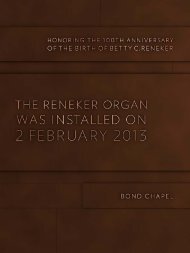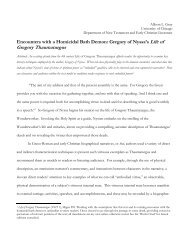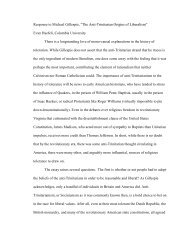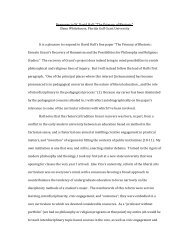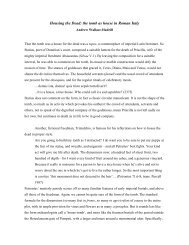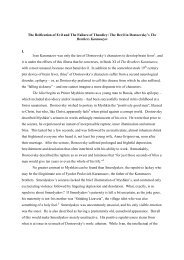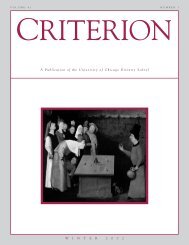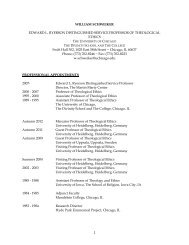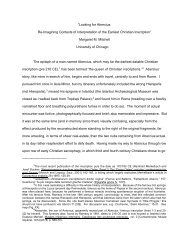THE ALTAR AND THE SCREEN: FILMMAKING AND WORLDMAKING S. Brent ...
THE ALTAR AND THE SCREEN: FILMMAKING AND WORLDMAKING S. Brent ...
THE ALTAR AND THE SCREEN: FILMMAKING AND WORLDMAKING S. Brent ...
Create successful ePaper yourself
Turn your PDF publications into a flip-book with our unique Google optimized e-Paper software.
Religion and Culture Web Forum<br />
June 2008<br />
<strong>THE</strong> <strong>ALTAR</strong> <strong>AND</strong> <strong>THE</strong> <strong>SCREEN</strong>:<br />
<strong>FILMMAKING</strong> <strong>AND</strong> <strong>WORLDMAKING</strong> 1<br />
S. <strong>Brent</strong> Plate<br />
Hamilton College<br />
All invention and creation consist primarily of a new relationship between known parts. 2<br />
-Maya Deren<br />
The lights dim, the crowd goes quiet, and viewers begin to leave worries of this<br />
world behind, anticipating instead a new and mysterious alternative world that will soon<br />
envelop their eyes and ears. The screen lights up with previews of coming attractions,<br />
each beginning with that same deep, male voice:<br />
“In a world, where passion is forbidden…”<br />
“In a world, where you must fight to be free…”<br />
“In a world, where your best friend is a dog…”<br />
Films create worlds. They do not passively mimic or directly display what is “out there,”<br />
but actively reshape elements of the lived world and twist them in new ways that are<br />
projected on screen and given over to an audience. The attraction and promise of cinema<br />
is the way films offer glimpses into other worlds, even if only for ninety minutes at a<br />
time. We watch, hoping to escape the world we live in, to find utopian projections for<br />
improving our world, or to heed prophetic warnings for what our world might look like if<br />
1 This essay has been excerpted from the introduction to S. <strong>Brent</strong> Plate, Religion and Film: Cinema and the<br />
Re-Creation of the World (New York: Columbia University Press, July 2008).<br />
2 Maya Deren, “Cinematography: The Creative Uses of Reality,” in The Avant-Garde Film, P. Adams<br />
Sitney, ed. (New York: Anthology Film Archives, 1987), 69.
we don’t change our ways and get it right. In the theater we live in one world while<br />
viewing another, catching a glimpse of “what if?”<br />
Yet, in the practice of film viewing, these two worlds begin to collide, leaking<br />
ideas and images across the semi-permeable boundaries between the world-on-screen and<br />
the world-on-the-streets. Such world-colliding activity is entertainingly exemplified in<br />
Woody Allen’s 1985 film Purple Rose of Cairo. Here, the fluidity between the worlds is<br />
enacted when the actor named Tom Baxter (played by Jeff Daniels) steps down off the<br />
screen and enters the “real world” in which Cecilia (Mia Farrow) sits, seeking relief from<br />
her otherwise troubled life. In Allen’s film, two worlds cross and both characters are<br />
altered because of their shared desires that transcend the boundaries of the screen.<br />
Nonetheless, The Purple Rose of Cairo does not let go of the fact that there is a screen in<br />
place between Tom and Cecilia. The screen is a border that is crossable, yet there are<br />
distinctions between the two sides, for example when Tom enters Cecilia’s world and<br />
takes her out for a night on the town and tries to pay for dinner with the fake prop money<br />
he has in his pocket. They eventually come to realize they live in two worlds and a<br />
permanent connection is impossible. Of course, all this takes place on screen, and not in<br />
the real world per se.<br />
Woody Allen’s film, while delightfully self-referential about the experience of<br />
cinema, also tells us much about the experience of religion. As I argue throughout my<br />
forthcoming book, Religion and Film: Cinema and the Re-Creation of the World,<br />
religions function like films, and vice versa. Among the myths, rituals, symbols,<br />
doctrines, sacred times and places, and ethical components of religions, the faithful are<br />
presented with alternate worlds, prescriptions for a better life, and imaginative tools for<br />
2
e-viewing the world as it is. Religions provide promises, warnings, and compelling<br />
narratives for behaving in particular (and often peculiar) ways. In each, there is an initial<br />
world lived in, and then a secondary, projected, idealized world. In the midst of this,<br />
communities of religious adherents work out their lives betwixt and between the two<br />
worlds. Powerful stories in the form of myths keep religious imaginations inspired, while<br />
aesthetic performances in the form of rituals keep human bodies moving to a rhythm.<br />
Even so, when the story is over, when the chanter has finished, when the feast has been<br />
eaten, we return to our everyday world. The two worlds seem to remain in a state of<br />
separation, yet there are many avenues for connection between them.<br />
Religions and films each create alternate worlds utilizing the raw, abstract<br />
material of space and time, bending them each in new ways and forcing them to fit<br />
particular standards and desires. Film does this through camera angles and movements,<br />
framing devices, lighting, costuming, acting, editing, and other aspects of production.<br />
Religions achieve this through setting apart particular objects and periods of time and<br />
deeming them “sacred,” through attention to specially charged objects (symbols), through<br />
the telling of stories (myths), and by gathering people together to focus on some<br />
particular event (ritual). The result of both religion and film is a re-created world: a world<br />
of recreation, a world of fantasy, a world of ideology, a world we may long to live in or a<br />
world we wish to avoid at all costs. The world presented at the altar and on the screen<br />
connects a projected world to the world of the everyday. Religion and film are akin. This<br />
is not to say they are equated; rather to say there are analogies that can be drawn between<br />
them.<br />
3
My approach then is about the connection of the world “out there,” and the re-<br />
created world on screen and at the altar, and how these worlds mutually impact one<br />
another. The impact, furthermore, is often so great that participants do not see differences<br />
in the worlds but rather view them as a seamless whole. Religious worlds are so<br />
encompassing that devotees cannot understand their personal worlds any other way;<br />
filmic worlds are so influential that personal relationships can only be seen through what<br />
has been seen on screen. My hypothesis is that by paying attention to the ways films are<br />
constructed, we can shed light on the ways religions are constructed, and vice versa. Film<br />
production borrows millennia-old aesthetic tactics from religions—at the dawn of the<br />
twentieth century filmmakers were more self-conscious about this then they are at the<br />
start of the twenty-first century—but contemporary religious practices are likewise<br />
modified by the pervasive influence film has had on modern society.<br />
To create this relationship, I play the role of editor, or perhaps of bricoleur,<br />
juxtaposing film theory and religious theory in order to highlight the ways both religion<br />
and film are engaged in the practice of worldmaking. As intimated by avant-garde<br />
filmmaker Maya Deren in the epigraph above, invention and creation do not operate by<br />
bringing something into being “out of nothing” (a troubling myth of creativity<br />
perpetuated by Christian theology and a romantic view of the modern artist alike), but of<br />
taking what is already known and creating a new relationship. There is nothing new<br />
under the sun, but there are new relationships between old substances. Along these lines,<br />
I adopt the language of the great Soviet filmmaker Sergei Eisenstein, who once wrote of<br />
the social value of “intellectual montage,” in which new and revolutionary ideas might<br />
spring from the juxtaposition of previously separate images. And to be interdisciplinary<br />
4
about it, I juxtapose Eisenstein with the words of religionist Wendy Doniger who<br />
suggests of the comparative study of religion: “The comparatist, like the surrealist, selects<br />
pieces of objets trouvés; the comparatist is not a painter but a collagist, indeed a<br />
bricolagist (or a bricoleur), just like the mythmakers themselves.” 3 Worlds, religious and<br />
filmic, are made up of borrowed fragments and pasted together in ever-new ways; myths<br />
are updated and transmediated, rituals reinvented, symbols morphed. By lighting up<br />
religious studies and film studies side by side, I hope to re-create the understanding of the<br />
relation between religion and film.<br />
In the remainder of this essay I briefly examine the concept of worldmaking and<br />
re-creation more fully from a religious studies standpoint. Then I introduce the ways<br />
films participate in worldmaking activities through filmmaking techniques. Along the<br />
way, I suggest that both activities can be seen in light of the other.<br />
I. Religious Worldmaking and Re-creation<br />
In the background of my argument are the world-building and world-maintaining<br />
processes of religion brought out in Peter Berger’s now-canonic work, The Sacred<br />
Canopy. We humans, the sociologist of religion suggests, collectively create ordered<br />
worlds around us to provide us with a sense of stability and security, “in the never<br />
completed enterprise of building a humanly meaningful world.” 4 Reality, like religion<br />
and like cinema, is socially constructed, allowing its members to engage with it on deeply<br />
felt, personal levels. Cultural products such as film offer conduits of significance between<br />
the individual and the cosmic order of the universe. And if culture staves off<br />
3 Wendy Doniger, The Implied Spider (New York: Columbia University Press, 1998), 77.<br />
4 Peter Berger, The Sacred Canopy (Garden City, NY: Doubleday, 1967), 27.<br />
5
meaninglessness at the societal level, religion does so at a cosmic level by constructing a<br />
“sacred canopy” that keeps the threatening forces of chaos at bay.<br />
Ever important is the grounding of human laws and regulations in cosmic<br />
structures. The nomos must be in synch with the cosmos. There is a dialectical, on-going<br />
process between the human and divine realms, and it is religion that supplies the link:<br />
“Religion implies the farthest reach of man’s self-externalization, of his infusion of<br />
reality with his own meanings. Religion implies that human order is projected into the<br />
totality of being. Put differently, religion is the audacious attempt to conceive of the<br />
entire universe as being humanly significant.” 5<br />
Indeed, Berger himself states that while most of history has seen religion as key to<br />
creating such a meaningful totality, in modern times “there have been thoroughly secular<br />
attempts at cosmization.” 6 Science has most importantly made the attempt, but here I am<br />
suggesting that we think about cinema as another audacious attempt. Cinema may be part<br />
of the symbol creating apparatus of culture, yet it can also aspire to more, to world-<br />
encompassing visions of the nomos and cosmos.<br />
The philosopher Nelson Goodman similarly understands the culturally/socially<br />
constructed nature of the world, particularly as found in his book, Ways of Worldmaking.<br />
Approaching the topic from an epistemological standpoint rather than Berger’s<br />
sociological one, Goodman draws an analogy between philosophy and the arts to<br />
understand how we humans go about creating worlds around us. Goodman suggests,<br />
“Much but by no means all worldmaking consists of taking apart and putting together,<br />
often conjointly: on the one hand, of dividing wholes into parts and partitioning kinds<br />
5<br />
Ibid., 27-8.<br />
6<br />
Ibid., 27.<br />
6
into subspecies, analyzing complexes into component features, drawing distinctions; on<br />
the other hand, of composing wholes and kinds out of parts and members and subclasses,<br />
combining features into complexes, and making connections.” 7 The activity of world<br />
creation is a process of taking things apart and putting them back together, of<br />
reassembling the raw materials available, of dissection and analysis, and of mending<br />
fragments. Such philosophical/religious activity is easily translatable in terms of<br />
filmmaking, through the framing of space through cinematography and reprojecting it on<br />
screen, or with its partitioning of time through cuts and recombination done in the editing<br />
room.<br />
I borrow the language of worldmaking from Berger and Goodman, but in the<br />
background is the work of Immanuel Kant, Émile Durkheim, and others. Meanwhile,<br />
scholar of comparative religion, William Paden, has synthesized many of these studies,<br />
offering evocative and accessible ways to approach both religion and film. On Paden’s<br />
view, religions posit and construct their own version of “the” world through various<br />
organizing categories made up of the activities, behaviors, beliefs, language, and symbol<br />
usages of persons and communities. By looking at religious systems as “worlds,” as<br />
opposed to the relatively disembodied examination of texts and doctrines, the student of<br />
religion can come to understand the broader environmental constructions of religious<br />
practices and traditions within particular places and times.<br />
Paden says, “Religions do not all inhabit the same world, but actually posit,<br />
structure, and dwell within a universe that is their own. . . . [A]ll living things select and<br />
7 Nelson Goodman, Ways of Worldmaking (Indianapolis: Hackett Publishing, 1978), 7.<br />
7
sense ‘the way things are’ through their own organs and modes of activity.” 8 “Any<br />
world,” Paden states elsewhere, “is an open-ended, interactive process, filled with various<br />
and complex sensory and cognitive domains, encompassing both representation and<br />
practice, both imaginal objects and bodies-in-performance.” 9 Central here are the<br />
processes of selection and organization, of an active, performative, ongoing creation of<br />
the world. Such language runs uncannily parallel to the language of film production, as<br />
each film (and, indeed, the film industry as a whole) offers specific geographies, times,<br />
languages, and personas; and is filled with many sensory details (though, unlike religion,<br />
must remain limited to sight and sound, and arguably, touch), intellectual suggestions,<br />
imaginary and “real” objects, and performing bodies.<br />
Worldmaking is an active engagement with the raw materials that make up what<br />
is in the strictest sense called the “earth,” and with the universe. Religions and films, as<br />
varieties of worldmaking enterprises, both achieve this. On the broadest and most abstract<br />
level, worldmaking makes use of the spaces and times that are available in the physical<br />
world, significantly incorporating common elements such as earth, air, fire, metal, wood,<br />
and water. Worldmaking is a performative drama in which humans are the costume<br />
designers and liturgists, scriptwriters and sermon givers, saints and cinematographers,<br />
priests and projectionists. All the world’s a stage, and all worlds are stages. The dramatic<br />
activity is what humans partake in when we attempt to make meaning of the spaces,<br />
times, and people that make up our lives. And it is what filmmakers, artists, and religious<br />
figures offer to this human drama.<br />
8<br />
William Paden, Religious Worlds: The Comparative Study of Religion, 2d ed. (Boston: Beacon, 1994),<br />
51-2.<br />
9<br />
William Paden, “World,” Guide to the Study of Religion, Willi Braun and Russell T. McCutcheon, eds.<br />
(London: Cassell, 2000), 336.<br />
8
When we get to analytical descriptions of mythic and ritualistic operations, we<br />
begin to see the dramatic nature of worldmaking unfold. Myths and rituals assist in the<br />
creation of worlds through activities that frame, exclude, focus, organize, and re-present<br />
elements of the known world. Anthropologist Mary Douglas speaks to the function of<br />
rituals, indirectly noting the power of mythic story: “A ritual provides a frame. The<br />
marked off time or place alerts a special kind of expectancy, just as the oft-repeated<br />
‘Once upon a time’ creates a mood receptive to fantastic tales…. Framing and boxing<br />
limit experience, shut in desired themes or shut out intruding ones.” 10 Meanwhile, Paden<br />
offers this definition for the function of ritual: “The basic feature of ritual is its power of<br />
focus…. In ritual, what is out of focus is brought into focus. What is implicit is made<br />
explicit. All ritual behavior gains its basic effectiveness by virtue of such undivided,<br />
intensified concentration and by bracketing off distraction and interference.” 11<br />
Similarly, for myth, Paden claims that it is “a definitive voice that names the<br />
ultimate powers that create, maintain, and re-create one’s life,” and that it works by<br />
“organizing and presenting reality in a way that makes humans not just conceivers but<br />
respondents and partakers.” 12 I am not suggesting these brief examples are<br />
comprehensive definitions of these terms, rather introducing the ways myth and ritual<br />
participate in the larger process of worldmaking. As should be somewhat apparent, myths<br />
and rituals operate like films: they utilize techniques of framing, thus including some<br />
themes, objects, and events while excluding others; and they serve to focus the<br />
participants’ attention in ways that invite humans into its world to become participants.<br />
10 Mary Douglas, Purity and Danger (New York: Routledge, 2002), 78.<br />
11 Paden, Religious Worlds, 95-6.<br />
12 Ibid., 73-4.<br />
9
Worlds are not merely created once and for all, they must be kept going,<br />
maintained. From time to time people will see through the constructed nature of the<br />
world and ask questions, poking holes in the sacred canopy. So, socio-cultural systems<br />
like religion have to continually legitimate the world that has been created. Worldmaking,<br />
in other words, is deeply bound to what Berger calls “world-maintenance.” Because there<br />
is a dialectical process between the projected societal views of the cosmos and individual<br />
inquiry and creativity, the world must be maintained on a perpetual basis. I transpose<br />
world-maintenance as “re-creation,” in order to get at the dynamic dialectics that Berger,<br />
Goodman, and Paden highlight. The world is not simply built, but is constantly being<br />
maintained through rebuilding, reconstruction, recombining.<br />
The hyphen is injected into re-creation to remind us how to pronounce this word<br />
in a way that resonates with its deeper meaning. Modern English has transformed the<br />
term into “recreation”—as in “recreational vehicle,” or departments of “parks and<br />
recreation”—it is something we do to get away from the world. Yet at the heart of the<br />
idea, even if we forget it, is the activity of creation. Recreation is a way to re-create the<br />
world, which often means taking a step back from the world to see how it is put together,<br />
if only to figure out how it can be rearranged. On those days of re-creation, the world<br />
looks different. We see what we should have seen all along. We remember what is truly<br />
important.<br />
That recreation, including movie-going, occurs on the weekends in the modern<br />
world is not accidental. These two days coincide with the Jewish and Christian holy days,<br />
when the good folk of the world attend religious services, participate in their “true”<br />
communities, and take time to be in touch with their Creator. At least, that’s the idea. As<br />
10
the Western world has grown restless with its religiosity, new forms of re-creation have<br />
emerged, one of which is of course the world of cinema. Indeed, what preacher’s sermon<br />
can compete with multi-million dollar special effects? What Sabbath meal can steer us<br />
away from the possibilities that such beautiful people as Julia Roberts and Richard Gere<br />
might fall in love? Indeed, many priests and pastors are now incorporating film clips into<br />
their very sermons, creating a multi-mediated spectacle of the Sunday morning worship<br />
service.<br />
The Jewish tradition of the Sabbath is particularly insightful as a way to approach<br />
the re-creation of the world as it relates to film. “On the seventh day, God rested,” we are<br />
told in the mythical language at the beginning of Genesis. But in the next chapter we read<br />
that the Creator was not so passive at this time. If religions, in contemporary religious<br />
studies language, are centered around that which is “sacred,” then the Jewish and<br />
Christian traditions would be first and foremost centered around the Sabbath day, for that<br />
is the first thing that God blesses and makes holy (Heb. kadosh) according to the<br />
scriptures: “God blessed the seventh day and made it holy” (Gen 2.3).<br />
As Abraham Heschel puts it in his classic little book on the Sabbath, “It is a day<br />
on which we are called upon to share in what is eternal in time, to turn from the results of<br />
creation to the mystery of creation; from the world of creation to the creation of the<br />
world.” 13 Contrary to public opinion, the idea of the Sabbath is not one hollowed out by a<br />
list of rules and regulations leaving a community in a state of passivity, but rather is an<br />
active, vital time. Judaism has a strong tradition of understanding the Sabbath as the<br />
completion of creation; on the seventh day God did not refrain from creating as much as<br />
13 Abraham Heschel, The Sabbath: Its Meaning for Modern Man (New York: Farrar, Straus, Giroux,<br />
1951), 10.<br />
11
God created the Sabbath. The Sabbath, on this view, is the “real world,” the rest of the<br />
week a necessary other world. “The Sabbath is not for the sake of the weekdays; the<br />
weekdays are for the sake of the Sabbath.” 14<br />
If the Sabbath is the day we turn “to the mystery of creation” and “from the world<br />
of creation to the creation of the world,” then film mimics this very process. Film makes<br />
us wonder about the world again, makes us say “Wow!” offers images that allow us to<br />
see things in a new way. This is not to say all film accomplishes this, for there seems to<br />
be somewhat of an inverse relation between the spectacular images of film and the<br />
capacity for the viewer’s imagination—the more dazzling the image, the more depressed<br />
the imagination—but then again, the challah bread, the candles, the recitation of prayers,<br />
are not fool-proof ways to stir our minds and bodies either. At its best, the Sabbath puts<br />
people in touch with their Creator, with their family, and with the created world. Bobby<br />
Alexander defines the aims of religious rituals in general, “Traditional religious rituals<br />
open up ordinary life to ultimate reality or some transcendent being or force in order to<br />
tap its transformative power.” 15 At its best, film puts people in touch with the world again<br />
in new ways. In both of these, one is connected with their world only by experiencing<br />
another world.<br />
To be active consumers and participants in front of the film screen, altar, or<br />
Sabbath table—in order to maintain the hyphen in re-creation—it is necessary at times to<br />
dissect and analyze, to take things apart and then recombine them, as Goodman suggests.<br />
As students of religion and film, we must see, hear, feel, and think through the ways these<br />
worlds are made and re-created.<br />
14 Ibid., 14. Heschel is paraphrasing the Zohar here.<br />
15 Bobby Alexander, “Ritual and Current Studies of Ritual,” in Anthropology of Religion, Stephen D.<br />
Glazier, ed. (Westport, CT: Greenwood Press, 1997), 139.<br />
12
II. Filmic Worldmaking and Re-Creation<br />
The re-creation of the world is perhaps so obvious in the cinema that we tend to<br />
overlook it. In the beginning, every film begins with the production studio’s logo. Many<br />
of these self-consciously demonstrate the ways in which the world is not simply being<br />
reflected on screen, but the way the world is being actively reimagined, and the way<br />
cinema functions to relate the nomos and cosmos. These moving logos continually<br />
portray a predominant theme through their scenarios: the heavens and earth are connected<br />
through the productions of cinema. The logo for Universal Studios depicts a spinning<br />
earth, with a thousand points of light appearing across the continents (presumably movie<br />
theaters) as the view zooms out to show the whole globe, and the name “Universal” spins<br />
into place as a belt spanning the planet. Dreamworks’ logo begins with an image of still<br />
water, into which a fishing line is dropped, then the camera moves up to find a boy<br />
cradled in the curve of the “D” of “Dreamworks” as the name hangs, suspended in mid-<br />
air and surrounded by clouds, evoking a lunar look on the world below. Elsewhere,<br />
Warner Brothers displays the “WB” shield floating amongst the clouds; the now-defunct<br />
Orion showed its eponymous star sign; and Paramount and Columbia both set their icons<br />
so high up on a pedestal that only the clouds and a few other mountain peaks can join<br />
them in their pantheon of world imagining.<br />
Through such examples it is clear that film production companies are fully<br />
cognizant of the other worlds and ethereal perspectives they provide for their viewers,<br />
and gleefully promote these perspectives as they reaffirm a cosmology that evokes a<br />
“looking up” to where the wondrous things are. In this way cinema offers a glimpse of<br />
13
the heavens, of other worlds above and beyond earthly existence, even as these other<br />
worlds must be relatable to the visible worlds on earth.<br />
Such posturing is not far from the need for religious worlds to legitimate their<br />
worldmaking activity. As Berger suggests, “Religion legitimates social institutions by<br />
bestowing upon them an ultimately valid ontological status, that is, by locating them<br />
within a sacred and cosmic frame of reference.” Further, “Probably the most ancient form<br />
of this legitimation is the conception of the relationship between society and cosmos as<br />
one between microcosm and macrocosm. Everything ‘here below’ has its analogue ‘up<br />
above.’ By participating in the institutional order men, ipso facto, participate in the divine<br />
cosmos.” 16 Likewise, cinema “projects” a particular human order onto a screen,<br />
promoting its productions as a link between the “here below” and “up above”—on<br />
mountain tops, in the clouds, encircling the earth. At the same time, the screen is literally<br />
created to be larger than life. Transcendent of this-worldly concerns, rules, or behaviors,<br />
the cinema enables a god’s-eye view of things, even if we have long ago given up the<br />
“heaven above/earth below” cosmic separation.<br />
Filmmakers and theorists, alongside production companies, realize the re-creative<br />
activity of film production as well, and they tend to understand worldmaking in terms of<br />
space and time. Siegfried Kracauer, in his Theory of Film, suggests the spatial<br />
significance of the larger than life images and the ways in which worlds are remade when<br />
projected on screen: “Any huge close-up reveals new and unsuspected formations of<br />
matter; skin textures are reminiscent of aerial photographs, eyes turn into lakes or<br />
volcanic craters. Such images blow up our environment in a double sense: they enlarge it<br />
16 Berger, Sacred Canopy, 33-4.<br />
14
literally; and in doing so, they blast the prison of conventional reality, opening up<br />
expanses which we have explored at best in dreams before.” 17 And editor Paul Hirsch<br />
connects worldmaking to the temporal dimensions of filmmaking when he claims, “Film<br />
is truth, but it’s all an illusion. It’s fake. Film is deceptive truth! ... Editing is very<br />
interesting and absorbing work because of the illusions you can create. You can span<br />
thirty years within an hour and a half. You can stretch a moment in slow motion. You can<br />
play with time in extraordinary ways.” 18<br />
Through the very technology of film, a new world is assembled—through the<br />
camera lens and in the editing room—and then projected on screen. Viewers see the<br />
world, but see it in entirely new ways because everyday perceptions of space and time are<br />
altered. Such time and space travel are not foreign to the procedures of religious<br />
worldmaking. In fact, if one were to substitute the word “myth” for “film” in Hirsch’s<br />
comment, we would come across a popular definition of myth: “Telling lies to tell the<br />
truth.” And through the re-creation of time and space, we have a world, created anew.<br />
III. Crossing Religion and Film<br />
In the 1950s, the aesthetician-cum-film theorist Etienne Souriau made a scientific<br />
stab at distinguishing several layers of “reality” when dealing with film, and<br />
17 Siegfried Kracauer, Theory of Film: The Redemption of Physical Reality (Princeton: Princeton<br />
University Press, 1997), 48. Relatedly, see Walter Benjamin’s suggestions in Selected Writings III, edited<br />
by Howard Eiland and Michael W. Jennings (Cambridge, MA: Belknap Press of Harvard University Press,<br />
2002), 117; and my own comments on the subject in Walter Benjamin, Religion, and Aesthetics (New<br />
York: Routledge, 2004), 105-112.<br />
18 Paul Hirsch, “Percussive Editing,” in First Cut: Conversations with Film Editors, Gabriella Oldham, ed.<br />
(Berkeley: University of California Press, 1992), 188-9. The philosopher Stanley Cavell was way ahead of<br />
some of this argument as he turned to the projections of film as a way of understanding the world. His book<br />
The World Viewed (enlarged edition; Cambridge, MA: Harvard University Press, 1979) argues that the<br />
world as it is holds a distinct relation to the “world viewed” on screen, and that the two are not entirely<br />
distinguishable, even if the screened world goes out of existence when the film is over. Yet, just below the<br />
surface of Cavell’s writings is a suggestion that cinema is ultimately a private, anonymous experience.<br />
15
inadvertently offers some suggestions to religious studies scholars interested in film. His<br />
levels are:<br />
1. afilmic reality (the reality that exists independently of filmic reality)<br />
2. profilmic reality (the reality photographed by the camera)<br />
3. filmographic reality (the film as physical object, structured by techniques<br />
such as editing)<br />
4. screenic (or filmophanic) reality (the film as projected on a screen)<br />
5. diegetic reality (the fictional story world created by the film; the type of<br />
reality “supposed” by the signification of film.)<br />
6. spectatorial reality (the spectator’s perception and comprehension of a film)<br />
7. creational reality (the filmmaker’s intentions) 19<br />
I note these here to further evidence the multiple layers of reality that one must engage<br />
when dealing with film. It is not enough to encapsulate the narrative arc, and suggest<br />
some religious implications from a literary perspective; rather, the edited,<br />
cinematographic, and projected layers of film’s re-creation of the world must be taken<br />
into account.<br />
And while these seven layers are each of individual interest, the full implications<br />
complicate the more general analogous relations I am attempting here. One could, I<br />
suppose, discuss each of these layers in ways that relate to Clifford Geertz’s extensive<br />
definition of religion, defined as: “(1) a system of symbols which acts to (2) establish<br />
powerful, pervasive, and long-lasting moods and motivations in men by (3) formulating<br />
conceptions of a general order of existence and (4) clothing these conceptions with such<br />
an aura of factuality that (5) the moods and motivations seem uniquely realistic.” 20<br />
Souriau’s level 2 could relate to Geertz’s point 3, Souriau’s level 4 could relate to<br />
19<br />
These levels are quoted from Warren Buckland, The Cognitive Semiotics of Film (Cambridge, UK:<br />
Cambridge University Press, 2000), 47. See Etienne Souriau, L’Univers filmique (Paris: Flammarion,<br />
1953). Souriau’s work has not been translated into English, but good overviews include chapter 3 of<br />
Edward Lowry’s The Filmology Movement and Film Study in France (Ann Arbor, MI: UMI Research<br />
Press, 1985).<br />
20<br />
Clifford Geertz, “Religion as a Cultural System,” in The Interpretation of Cultures (New York: Basic<br />
Books, 1973), 90.<br />
16
Geertz’s point 4, Souriau’s level 6 could relate to Geertz’s point 5, and so forth. The key<br />
point I take from Souriau is the general distinction between the profilmic and afilmic<br />
realities, the world “on screen,” and the world “out there,” but also of their mutual<br />
implication.<br />
Finally, to bring this theoretical filmic and religious re-creating of the world down<br />
to a more concrete level, consider the following brief note on the production of Terry<br />
Gilliam’s film Tideland:<br />
Terry Gilliam filmed his newest movie, Tideland, in Saskatchewan last<br />
fall, racing to complete the location shots before winter set in. The Mitch Cullin<br />
novel on which the film is based is mostly set in West Texas, but Mr. Gilliam had<br />
substituted the Canadian prairie instead. The evening after he wrapped, it started<br />
to snow, and the cast, crew and director all saw this as an omen….<br />
Most of Tideland takes place inside a long-abandoned farmhouse, and the<br />
set was a miracle of grunginess and dilapidation in which cobwebs had been<br />
applied, brand new walls had been distressed to look old and water-stained, and<br />
ancient household implements had been knocked around until they looked even<br />
older. But as the camera tracked around and the crew moved props in and out,<br />
they accidentally created little pathways of relative orderliness, and Mr. Gilliam<br />
several times called for more dust. 21<br />
In the making of film—which is not far from the making of religion—through symbolic<br />
representational images, scenarios can be substituted, just as afilmic weather encroaches<br />
on profilmic realities, and even entropy can be created on screen. On the flip side,<br />
viewers end up seeing this re-created world on screen, believing in the fiction, because<br />
such belief is how we humans survive our everyday life. We go to the cinema and to the<br />
temple for recreation, to escape, but we also crave the re-creative aspects, maintaining the<br />
canopy of meaning over our individual and social lives as we imagine how the world<br />
could be. What if?<br />
21<br />
Charles McGrath, “Terry Gilliam’s Feel-Good Endings,” New York Times, 14 August 2005. Available<br />
at:<br />
http://www.nytimes.com/2005/08/14/movies/14mcgr.html?ex=1124769600&en=b8eac6b20a90d575&ei=5<br />
070&emc=eta1 (accessed 15 August 2005).<br />
17


